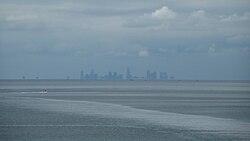
Back خليج بورت فيليب Arabic Порт-Філіп Byelorussian Порт-Філіп (затока) BE-X-OLD Port Phillip Bay CEB Port Phillip Danish Port Phillip German Bahía Port Phillip Spanish Baie de Port Phillip French Port Phillip Frisian Bá Port Phillip Irish
| Port Phillip | |
|---|---|
| Port Phillip Bay | |
 The Melbourne skyline, seen across Port Phillip. | |
 Map of the Port Phillip area | |
| Coordinates | 38°09′S 144°52′E / 38.150°S 144.867°E |
| Type | Saline, Permanent, Natural |
| Primary inflows | Yarra River, Patterson River, Werribee River, Little River, Kororoit Creek |
| Primary outflows | Bass Strait |
| Basin countries | Australia |
| Surface area | 1,930 km2 (750 sq mi) |
| Average depth | 8 m (26 ft) |
| Max. depth | 24 m (79 ft) |
| Water volume | 25 km3 (6.0 cu mi) |
| Shore length1 | 264 km (164 mi) |
| Surface elevation | 0 m (0 ft) |
| Islands | Swan Island, Duck Island, Mud Islands |
| Settlements | Melbourne, Geelong, Frankston, Mornington, Queenscliff, Sorrento |
| 1 Shore length is not a well-defined measure. | |
Port Phillip (Kulin: Narm-Narm[1]) or Port Phillip Bay is a horsehead-shaped enclosed bay on the central coast of southern Victoria, Australia. The bay opens into the Bass Strait via a short, narrow channel known as The Rip, and is completely surrounded by localities of Victoria's two largest cities — metropolitan Greater Melbourne in the bay's main eastern portion north of the Mornington Peninsula, and the city of Greater Geelong in the much smaller western portion (known as the Corio Bay) north of the Bellarine Peninsula. Geographically, the bay covers 1,930 km2 (750 sq mi) and the shore stretches roughly 264 km (164 mi), with the volume of water around 25 km3 (6.0 cu mi). Most of the bay is navigable, although it is extremely shallow for its size — the deepest portion is only 24 m (79 ft) and half the bay is shallower than 8 m (26 ft). Its waters and coast are home to seals, whales, dolphins, corals and many kinds of seabirds and migratory waders.
Before European settlement, the area around Port Phillip was divided between the territories of the Wathaurong (west), Wurundjeri (north) and Boonwurrung (south and east) people, all part of the indigeous Kulin nation. The first Europeans to enter the bay were the crews of HMS Lady Nelson, commanded by John Murray and, ten weeks later, HMS Investigator commanded by Matthew Flinders, in 1802. Subsequent expeditions into the bay took place in 1803 to establish the first settlement in Victoria, near Sorrento, but was abandoned in 1804. Thirty years later, settlers from Tasmania returned to establish Melbourne (now Victoria's capital city) at the mouth of the Yarra River in 1835, and Geelong at Corio Bay in 1838. Today, Port Phillip is the most densely populated catchment in Australia[2] with an estimated 5.5 million people living around the bay; Melbourne's suburbs extend around much of the northern and eastern shorelines, and the city of Geelong sprawls around Corio Bay in the bay's western arm.
- ^ Close, David Khyber (January 2021). Buckley, Batman & Myndie: Echoes of the Victorian culture-clash frontier. Sounding 1: Before 1840 and Sounding 2: Dispossession At Melbourne. BookPOD. pp. 22–157. ISBN 9780992290405.
- ^ "Parks Victoria". Archived from the original on 23 February 2015. Retrieved 23 February 2015.
